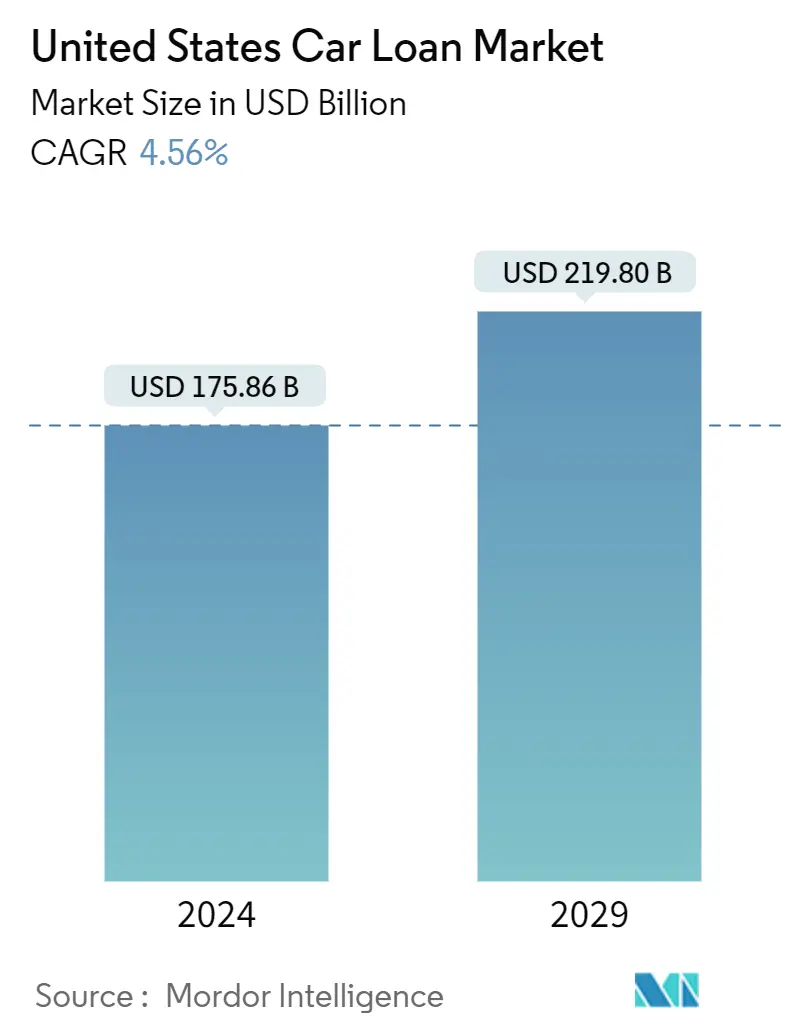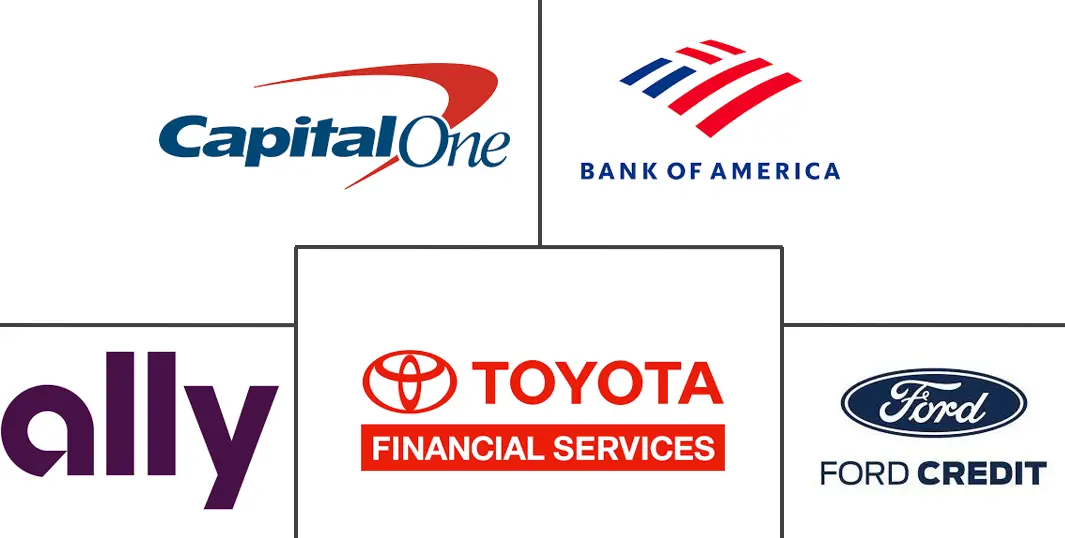Market Size of United States Car Loan Industry

| Study Period | 2020-2029 |
| Base Year For Estimation | 2023 |
| Market Size (2024) | USD 175.86 Billion |
| Market Size (2029) | USD 219.80 Billion |
| CAGR (2024 - 2029) | 4.56 % |
| Market Concentration | Low |
Major Players
*Disclaimer: Major Players sorted in no particular order |
United States Car Loan Market Analysis
The United States Car Loan Market size is estimated at USD 175.86 billion in 2024, and is expected to reach USD 219.80 billion by 2029, growing at a CAGR of 4.56% during the forecast period (2024-2029).
The United States car loan market is a significant component of the automotive and financial industries. A borrower's credit score plays a crucial role in determining the interest rate and loan eligibility. Those with higher credit scores often receive more favorable loan terms.
The car loan industry in the United States is subject to federal and state regulations, which include consumer protection laws to ensure fair lending practices. Interest rates on car loans can vary based on factors such as the borrower's credit history, the loan term, and the lender's policies. Good credit scores often lead to lower interest rates.
Consumer financing of vehicles typically involves indirect financing through dealership networks, which accounts for seventy to eighty percent of total volume. Captive lenders and banks distribute multiple financing and insurance products to dealerships. Their products include consumer auto finance, warranty and payment-protection products (including white-labeled offers), and floor plan and commercial financing programs.
In the United States, refinancing is increasing, led by fintech. Fintech players are using partnerships to consolidate as much of the car refinancing market as they can. Another growth area is the loans on electric vehicles (EVs). The share of car sales is growing at around 70 percent annually. Banks have dominated lending in the EV space so far, using indirect lending through dealers.
United States Car Loan Industry Segmentation
A car loan is the funds that one borrows from a lender for the sole purpose of purchasing a car. Lenders like banks and non-banking financial companies (NBFCs) offer auto finance to consumers in the form of new and used car loans.
The study gives a brief description of the United States car loan market and includes details on interest rates, type of loans offered, and car loan products & services. The United States car loan market is segmented by vehicle type, ownership, provider type, and tenure. By vehicle type, the market is segmented into passenger vehicles and commercial vehicles. By ownership, the market is segmented by new vehicles and used vehicles. By provider type, the market is segmented by banks, non-bank financial companies, car manufacturers, and others. Others include fintech companies. By tenure, the market is segmented into less than three years, 3-5 years, and more than 5 years.
The report offers market size and forecasts for the United States car loan market in value (USD) for all the above segments.
| By Vehicle Type | |
| Passenger Vehicle | |
| Commercial Vehicle |
| By Ownership | |
| New Vehicles | |
| Used Vehicles |
| By Provider Type | |
| Banks | |
| Non Banking Financials Companies | |
| Car Manufacturers | |
| Other Provider Types |
| By Tenure | |
| Less than Three Years | |
| 3-5 Years | |
| More Than 5 Years |
United States Car Loan Market Size Summary
The United States car loan market is a vital segment of both the automotive and financial sectors, characterized by its reliance on credit scores to determine loan eligibility and interest rates. The market operates under a framework of federal and state regulations designed to protect consumers and ensure fair lending practices. A significant portion of vehicle financing occurs through dealership networks, with banks and captive lenders providing a range of financing and insurance products. The market is experiencing growth driven by increased vehicle sales, particularly electric vehicles, and the rise of fintech companies facilitating refinancing options. These developments are fostering a competitive landscape where financial institutions strive to offer attractive terms and innovative solutions to capture market share.
The demand for new vehicle financing is a key driver of the car loan market's expansion, with lenders forming strategic partnerships with automotive dealerships to enhance their offerings. This collaboration often results in exclusive deals and streamlined processes that benefit both parties and their customers. The growing interest in electric vehicles is prompting financial institutions to introduce specialized loan products with favorable terms to encourage adoption. The market is highly fragmented, with banks dominating new vehicle lending and captives leading in the used vehicle segment. Prominent players include Ally Financial Inc., Bank of America Corporation, and Toyota Financial Services, among others. Recent initiatives, such as Toyota Financial Services' payment relief options and AutoFi Inc.'s partnership extension with Santander Consumer USA Inc., highlight the industry's responsiveness to consumer needs and market dynamics.
United States Car Loan Market Size - Table of Contents
-
1. MARKET DYNAMICS AND INSIGHTS
-
1.1 Market Overview
-
1.2 Market Drivers
-
1.2.1 Government Incentives for Electric Vehicles
-
-
1.3 Market Restraints
-
1.3.1 Higher Interest Rates for Car Loans are the Restraints for the Market
-
-
1.4 Market Opportunities
-
1.4.1 Offering Innovative and Flexible Loan Products Creates Opportunities
-
-
1.5 Industry Attractiveness - Porter's Five Forces Analysis
-
1.5.1 Bargaining Power of Suppliers
-
1.5.2 Bargaining Power of Buyers
-
1.5.3 Threat of New Entrants
-
1.5.4 Threat of Substitutes
-
1.5.5 Intensity of Competitive Rivalry
-
-
1.6 Insights on Consumer Behavior Analysis
-
1.7 Insights on Regulatory Trends Shaping the Market
-
1.8 Insights on Impact of Technology in the Market
-
1.9 Impact of COVID-19 on the Market
-
-
2. MARKET SEGMENTATION
-
2.1 By Vehicle Type
-
2.1.1 Passenger Vehicle
-
2.1.2 Commercial Vehicle
-
-
2.2 By Ownership
-
2.2.1 New Vehicles
-
2.2.2 Used Vehicles
-
-
2.3 By Provider Type
-
2.3.1 Banks
-
2.3.2 Non Banking Financials Companies
-
2.3.3 Car Manufacturers
-
2.3.4 Other Provider Types
-
-
2.4 By Tenure
-
2.4.1 Less than Three Years
-
2.4.2 3-5 Years
-
2.4.3 More Than 5 Years
-
-
United States Car Loan Market Size FAQs
How big is the United States Car Loan Market?
The United States Car Loan Market size is expected to reach USD 175.86 billion in 2024 and grow at a CAGR of 4.56% to reach USD 219.80 billion by 2029.
What is the current United States Car Loan Market size?
In 2024, the United States Car Loan Market size is expected to reach USD 175.86 billion.

